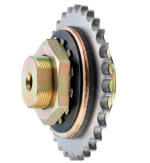ziyaddin2015
Lifetime Supporting Member
We have a pallet dispensing system that's chain driven. The forklift loads10 or so pallets in destaker then all these pallets except the bottom gets picked up to clear the pallet on the very bottom. The long cylinder drags the pallet and pushes it past the lugs. From there two drive chains with outside lugs move it forward. The pallet does not ride on a chain instead it gets pushed by lugs on both sides with two parallel chains to a sensor where the robot starts palletizing. The problem is that when we have a bad pallet that does not transfer properly it gets wedged between lugs and breaks the pallet. This only happens if the pallet is damaged which causes pallet jam. Also, the chain conveyor is mounted to the floor with screws and those get pulled off floor and chain jump the guides and the chain does not stop without wrecking things badly. We have two 525 drives that drive both chains. Is there a simple parameter change that can be done within the drive that would improve the situation. Any advice will be greatly appreciated.





